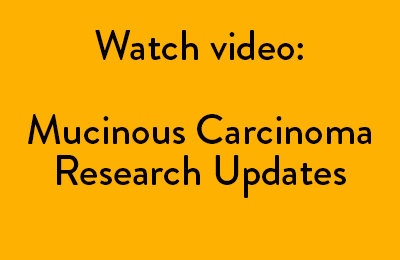Thursday, January 20, 2022
Tuesday, January 18, 2022
Mucinous Carcinoma
Mucinous Carcinoma
Mucinous carcinoma accounts for 25% of Stage 1 epithelial ovarian cancers, but only 5% of advanced stage epithelial ovarian cancers. It is often confused with gastrointestinal cancers. Overall survival for Stage 1 is similar to high-grade serous cancers (about 85% five-year survival). When diagnosed in advanced stages, mortality is significantly higher than for high-grade serous. Current standard therapy is surgery, followed by paclitaxel/carboplatin chemotherapy.
It’s been established that there are key pathways and potential targets, particularly for patients with mucinous carcinoma who have recurred. For this subset of patients, there are several areas of potential promise.
- Bevacizumab can be an active agent, which means the angiogenesis pathway is a key pathway.
- 22% have MSI-H (high levels of microsatellite instability), which means they may be responsive to immune checkpoint inhibitors.
- 18% have HER-2/neu amplification. Breast cancer drugs, such as trastuzumab, that target HER-2/neu may also be active in patients who express HER-2/neu amplification.
- 40-50% of patients have a RAS genetic mutation, and MEK inhibitors may be active in tumors that express a RAS mutation.
Current research into mucinous carcinoma is focused on further investigating the use of hyperthermic intraperitoneal chemotherapy (HIPEC), and on potential transition to more common use of gastrointestinal chemotherapy regimens.
HIPEC for ovarian cancer in general has shown to produce mixed results. Most experts consider it to be investigational, rather than standard of care treatment. However, there is interest in applying HIPEC for mucinous ovarian cancer specifically, due to HIPEC’s possible efficacy against gastrointestinal cancers, which microscopically looks quite similar to mucinous carcinoma of the ovary.
- A randomized trial investigated use of a regimen commonly used to treat colorectal cancer–capecitabine/oxaliplatin–versus paclitaxel/carboplatin, with or without addition of bevacizumab, in patients with previously untreated mucinous ovarian cancer. The concept was to determine if by giving the standard gastrointestinal treatment regimen, patients would have a higher response rate and progression-free survival. The trial unfortunately closed early due to slow accrual, so will not have a conclusion.
- In more conclusive news, a retrospective multi-institutional study on patients with mucinous carcinoma showed that patients who received gastrointestinal treatment regimens had significantly better progression-free and overall survival rate than those who received the standard of paclitaxel/carboplatin. Because this was retrospective, and not a randomized clinical trial, more investigation is needed, but researchers believe this shows promise.
Thursday, January 13, 2022
Tuesday, January 11, 2022
Malignant Ovarian Germ Cell Tumors
Malignant ovarian germ cell tumors represent less than 5% of all ovarian cancers, and occur primarily in girls and young women in their 20s and 30s. Prior to the 1970s, this type of tumor had a very high mortality rate, but since the introduction of contemporary BEP chemotherapy (bleomycin, etoposide, and cisplatin; a combination often used to treat testicular cancer), the cure rate is 95%. Because this type often affects only one ovary, fertility-sparing surgery is sometimes feasible.
- A low risk international study has enrolled children and adults with Stage 1A and 1B ovarian germ cell tumors that are confined to the ovaries. Patients in the study undergo observation following primary surgery, and receive chemotherapy only if they develop a recurrence. The concept is to try to avoid chemotherapy altogether in patients with very early stage disease. This trial is ongoing, with results expected in about 5 years.
- The same study, this one for patients ages up to 25 years old with Stage 1C-111 malignant ovarian germ cell ovarian cancer, compares the current standard BEP chemotherapy with a bleomycin, etoposide, carboplatin chemotherapy. Carboplatin is thought to be less toxic than cisplatin, and if results of the trial are positive, it will represent a major advancement in lessening short and long-term toxicity.
Thursday, January 6, 2022
Monday, January 3, 2022
Mirvetuximab Soravtansine Shows Promising Topline Results in FRα-High, Platinum-Resistant Ovarian Cancer
The antibody-drug conjugate mirvetuximab soravtansine has shown promising response rates and a favorable toxicity profile in patients with folate receptor alpha (FRα)-high, platinum-resistant ovarian cancer who have received previous treatment with bevacizumab (Avastin), according to topline results from the phase 3 SORAYA trial (NCT04296890) released by ImmunoGen Inc.1
Results showed that the trial met its primary end point, with a confirmed objective response rate (ORR) of 32.4% (95% CI, 23.6%-42.2%) per investigator assessment, and 31.6% (95% CI, 22.4%-41.9%) per blinded independent central review (BICR). Both the investigator- and BICR-assessed ORR included 5 complete responses (CRs). Furthermore, the median duration of response (DOR) was 5.9 months (95% CI, 5.6-7.7).
“Despite advances in the platinum-sensitive setting, most patients with ovarian cancer eventually develop platinum-resistant disease, for which there are limited treatment options, especially for those patients who have previously received bevacizumab,” Robert Coleman, MD, co-principal investigator, and chief scientific officer of US Oncology Research, said in a press release. “Data from SORAYA have the potential to redefine the standard of care for patients with FRα-high platinum-resistant ovarian cancer, as this trial has demonstrated that mirvetuximab delivers clinically meaningful benefit in this setting, with significant and durable responses and a favorable tolerability profile.”

